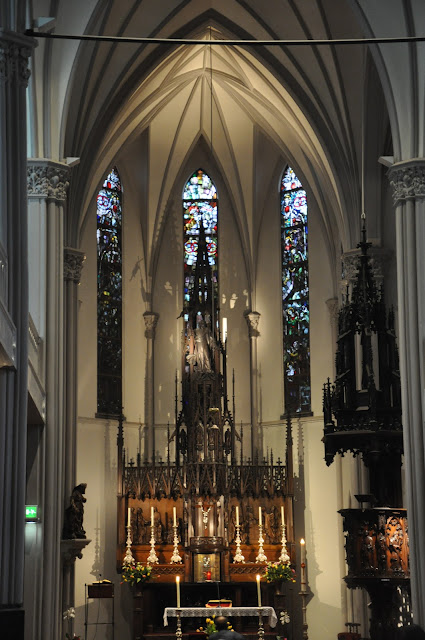In the 16th century after the Protestant Alteration, Catholic churches became Protestant churches and Catholics were no longer allowed to worship openly. However, the "tolerant" Dutch allowed Catholics to hold services in any private building providing that the exterior revealed no sign of their activities; hence the development of the city’s schuilkerken (clandestine churches). I suggest you visit two of these clandestine or hidden Catholic churches that were built in the 16th century.
One is pretty well known in the popular guide books:
Amstelkring, also known as Ons Lieve Heer op Solder (Our Lord in the Attic), is ironically located within the Red Light District on the Oudezijds Voorburgwal. Amstelkring, meaning “Amstel Circle”, is the name of the group of 19th century historians who saved the building from demolition. After the Rijksmuseum, it is the oldest museum in Amsterdam.

In 1661, a wealthy merchant bought a property on Oudezijds Voorburgwal comprising of a canal house plus two rear houses with the third floor forming a single extended attic with the top floors of the two back houses. Jan Hartman was Catholic, and since his son was training for the priesthood, Hartman decided to convert the top three floors of his house into a secret Catholic church. Behind the attic windows of this narrow canal house is a 150-seat three-story church.
By visiting Our Lord in the Attic, not only will you be able to see a perfect example of one of the “hidden" churches, it will also give you a chance to see how the wealthy lived in 16th and 17th century Amsterdam. After entering the house and showing your Museumkaart, climb the stairs and enter the enormous, highly ornate Sael or parlor--the best room of the house, a fine example of a living room decorated and furnished in the Dutch Classical style of the 17th century. This impressive hall, with its marble floor and painted paneled ceiling served as the reception room for the Hartman family, who lived here from 1661. The opulent decoration is in the Dutch classical style, emphasizing symmetry of form and ornament. The Sael looks just as it did in the 1660s.
By visiting Our Lord in the Attic, not only will you be able to see a perfect example of one of the “hidden" churches, it will also give you a chance to see how the wealthy lived in 16th and 17th century Amsterdam. After entering the house and showing your Museumkaart, climb the stairs and enter the enormous, highly ornate Sael or parlor--the best room of the house, a fine example of a living room decorated and furnished in the Dutch Classical style of the 17th century. This impressive hall, with its marble floor and painted paneled ceiling served as the reception room for the Hartman family, who lived here from 1661. The opulent decoration is in the Dutch classical style, emphasizing symmetry of form and ornament. The Sael looks just as it did in the 1660s.
Then move onto the Grachtenkamer or Canal Room. Unlike the formal parlor, this room was where the family lived and slept together. A box bed was built into the wall. The room's current size and shape dates from 1663. The room had no heating at that time, and since it was at the front, the noise and the smell of the canal were a problem. The room is fitted in 17th century style, with wall curtains and 17th century furniture, contemporary paintings and a collector's cabinet. A replica of a 17th century stove provided heating.

Around 1661, the owner converted the attic into a church, comprised of a nave and two balconies overhead to maximize the seating in this relatively small, but long and narrow space. The balconies are suspended from the ceiling and held in place by metal rods. The original church was extended in 1735 to create more seating space. Compared with the plain, whitewashed Protestant churches, this Catholic church has touches of elaborate, Baroque décor, with statues of saints, garlands and baby angels.
Our Lord in the Attic, Amsterdam Photo by: Neil Rickards

NOTE: The church is under renovation during 2010. Thus, all paintings, decorations and the organ have been removed (Rather disappointing!). Below is my personal photo of the church. All of the other rooms are intact as shown by my other posted photos.
Walk down the stairs to the confessional. Few churches would have had such a simple confessional chair. The penitent knelt in the closet-like space on the right to confess their sins to the priest who sat in a chair in the left room.
Down yet another flight of stairs will lead to the rear house. The first room you come to is the Jaap Leeuwenberg room, named after the former director and benefactor. Part of the floor of the extended space comprises wooden boards, and part consists of 17th century stone tiles that were discovered under the floorboards during restoration work in 1960.
This room will lead you to the restored 17th century kitchen.
The other hidden church isn't so well known but well worth the visit.
The Neo-Gothic façade of De Papegaai (note the statue of the parrot to the left of the gable). Photo courtesy of Iamsterdam.
On Amsterdam's busy pedestrian-only shopping street, squeezed between two shops and across from a McDonalds, is the neo-gothic gable of the H. H. Petrus en Pauluskerk, better known as De Papegaai or the Parrot. The church was built around 1700 in the garden of the house that was probably inhabited by a bird trader, hence the parrot on the gable. At the door of the church a large sign invites you to devote Een kwartier voor God (15 minutes for God).
Exit the hustle and bustle of busy Kalverstraat and enter the quiet solitude. You'll be amazed to see a beautiful church hidden behind the doors...
with an intricately-carved wooden pulpit and altarpiece,

And beautiful

Stained glass

Windows








